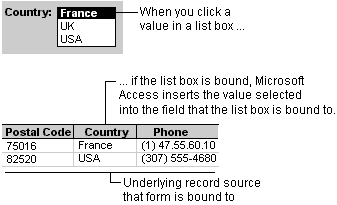
In many cases, it's quicker and easier to select a value from a list than to remember a value to type. A list of choices also helps to ensure that the value that's entered in a field is correct.
The list in a list box consists of rows of data. In a form, a list box can have one or more columns, which can appear with or without headings. If a multiple-column list box is bound, Microsoft Access stores the values from one of the columns. In a data access page, a list box has one column without a heading.

You can use an unbound list box to store a value that you can use with another control. For example, you could use an unbound list box to limit the values in another list box or in a custom dialog box. You could also use an unbound list box to find a record based on the value you select in the list box.
On a form, you can use a combo box instead of a list box; it takes up less room, and you can type new values in it, as well as select values from a list. Learn about combo boxes on forms.
On a data access page, you can use a drop-down list box instead of a list box; it takes up less room; however, you can't type new values in it. Learn about drop down list boxes on data access pages.